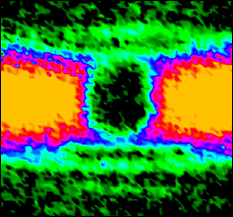News Story
Team Introduces World's First Invisibility Cloak

False color representation of the measured plasmon field scattering around the central area of the cloak. The flow of energy around the cloaked region is visualized.
A Clark School research team comprised of Visiting Research Scientist Igor Smolyaninov, Professor of Electrical and Computer Engineering Christopher Davis, and graduate student Yu-Ju Hung, has created the world's first true invisibility cloak.
The new cloak is just 10 micrometers in diameter; by comparison, a human hair is between 50 to 100 micrometers wide. The cloak works by guiding rays of light around an object hidden inside and releasing the light rays on the other side. This causes the light waves to appear to have moved in a straight line, making the cloak and the object inside of it invisible.
The group's research currently utilizes a two-dimensional demonstration of the cloak over a limited wavelength range. Three-dimensional invisibility cloaks represent a more significant challenge, requiring researchers to control light waves both magnetically and electronically to steer them around the hidden object.
The research team has made use of the unique properties of metamaterials, artificially structured substances that help control electromagnetic waves in unusual ways.
The cloak consists of a two-dimensional pattern of concentric gold rings coated in a plastic called polymethyl methacrylate. The plastic and the gold each have different refractive properties, and bend plasmons -- electron waves generated when light strikes a metallic surface -- in different directions. The whole arrangement lies flat on a gold surface. By varying the mix of metal and plastic in different areas of the cloak, the team can control and guide plasmons around the cloak, as water in a stream flows around a rock.
The team's research has been covered by the media, including New Scientist, and a manuscript describing the research is available online at http://arxiv.org/abs/0709.2862. The research was also included in Discover Magazine's Top 100 science stories of 2007.
View a press release about this technology online.
Published December 18, 2007









